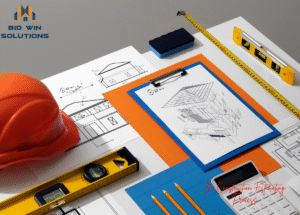
A Brief Introduction to Construction Estimating
Planning is made before any work in construction, and it is very important. Estimation is included in that planning. Estimating things provides a preliminary estimate of cost, materials, and time before the commencement of work. There is no doubt that without accurate estimation, there is a possibility of cost overrun, delay, or run-out of material.
In this article, we are going to discuss everything about what construction estimating is, why you should care, and how it’s done. You’ll also be able to learn tools, techniques, and best practices the pros use to write winning construction estimates.
What Is Construction Estimating?
Construction estimating is the science and art of estimating the cost and resources needed to accomplish the work. It includes materials, labor, equipment, subcontractor costs, overheads, and profit margins.
One estimates to set as close as possible to an estimated figure. It informs owners what they will pay for and provides contractors with a basis for cash and time flow.
Furthermore, the construction estimation is about more than numbers. It translates drawings, project specifications, and site conditions. Every bit of information counts because small errors will be evident in the finished product.
Why Construction Estimating Is Important?

An accurate construction estimate is applied for a variety of reasons:
- Budgeting: Staying within budget.
- Scheduling: Time is included in estimates, and that affects project schedules.
- Resource control: Proper estimates prevent material shortages or oversupply.
- Risk management: They enable the identification of potential trouble spots well before labor can even begin.
- Competitive bidding: Contractors rely on good estimates in order to get tenders and make profits.
Projects fall behind schedule, become contentious, and are more costly without good estimating.
Most Important Components of a Construction Estimate
An estimate is more than a number. It has various components, all complementing each other to give themselves collective accuracy.
1. Direct Costs
Direct cost of labour on the building, for example:
- Wages of labour.
- Materials such as concrete, steel, and timber.
- Equipment hire or buy.
2. Indirect Costs
They are the costs that are for the benefit of the project but are not charged to project activities. Examples are:
- Site utilities.
- Cost of project management.
- Safety and compliance charges.
3. Overhead and Profit
Contractors add overhead to cover the cost of offices and profit margins to enable business.
4. Contingency Allowances
Construction is construction; there are not always, it seems, precise plans. Estimators add a contingency percentage to enable allowance for uncertainty. Uncertain expenses are probable.
Types of Construction Estimates
Construction jobs require various skills at several phases. Some of the usual ones are mentioned below:
- Preliminary estimate: Used at an early planning phase, often on approximate details.
- Detailed estimate: Gives exact quantities, cost, and time when drawings are completed.
- Quantity takeoff: Measures and quantifies materials.
- Bid estimate: To be utilized in the bidding to allow for transmission to customers.
- Control estimate: During construction, align the actual cost with the estimated cost.
They are utilized for various purposes in the cost management of a project.
The Construction Estimating Process

Estimating is systematically carried out. This is the systematic process:
- Read project reports – Specs, plans, and scope of work.
- Walk around sites – Define physical conditions that affect costs.
- Take quantities – Measure and count all materials required.
- Assign unit prices – Price databases or supplier quotes to allocate load costs.
- Estimate labor hours – Pay rates and crew productivity.
- Include equipment requirements – Account for rental or buying equipment.
- Include indirect expenses – Add insurance, permit, and overhead fees.
- Add profit and contingency – Add risk mitigation and business needs levels.
- Final estimate – Re-calculate for detail and provide a professional report.
Construction Estimating Tools and Software
Tools are utilized by skilled estimators to become efficient and accurate. The common tools are given below:
- Spreadsheets: Most commonly used on small and medium projects.
- Takeoff software: Automatically calculates electronically from drawings.
- Construction estimating software: Allows cost, scheduling, and reporting all in one system.
- Pricing databases: Supply current material and labor costs to allow accurate estimating.
- Computers are time and error savers, so they’re standard now.
Manual vs. Digital Estimating

Numbers were done manually by estimators. Although good for small jobs, manual estimating is slow and provides more opportunity for error.
Today, it’s end-to-end electronics. Estimators can quote faster using software programs and input new prices in real-time. They even permit collaboration among teams by sharing through the cloud.
Fingers-on methods, though, are worth it. It allows estimators to create foundations and check hand software math.
Problems of Construction Estimating
Estimators typically have problems that can affect accuracy:
- Substandard drawings leading to a shortage of details.
- Price volatility of materials like steel or timber.
- Shortages in labor that change levels of productivity.
- Unforeseen site conditions, such as weather or ground conditions.
- Short deadlines that reduce the time to inspect proportionally.
No doubt, the seasoned estimators take these issues away by incorporating contingency and staying up to date with market trends.
Best Practices of Accurate Estimates
There are a few practices that are undertaken by seasoned professionals in an attempt to make construction estimating much more precise:
- Double-check all measurements and calculations.
- Keep up to date with material and labor rates within the local market.
- Employ standard templates to ensure consistency.
- Maintain open communication channels with subcontractors and suppliers.
- Pre-finalize estimates with project managers before submitting them.
- Record of work done statement for benchmarking purposes.
These processes reduce risk and create client confidence.
Role of Technology in Contemporary Estimating
Technology has dramatically transformed the construction estimating process. Some of the innovations are:
- Building Information Modeling (BIM): Offers 3D models to optimize material takeoffs.
- Cloud applications: Allow various stakeholders to edit and view estimates in real-time. Avoid duplication of effort.
- Mobile apps: Allow estimators to capture data in the field.
Technologies accelerate and improve accuracy as projects get more complex.
Advisory to Clients and Contractors
Construction estimating information benefits contractors and clients.
- For contractors: Separate estimating line items. Transparency is trust.
- For clients: Ask for broken-out estimates rather than a lump sum. Compare bids more easily.
For both: Keep lines of communication open throughout the project so there will be no misunderstandings.
Final Thoughts
Construction estimating isn’t number work. It’s a considered process that demands detail, construction acumen, and close watch over markets. Successful estimates drive budgets, schedules, and planning resources and are the bricks on which great projects are constructed.
Contractors rely on estimating to be competitive, and owners rely on it to make an informed decision. With the proper combination of human expertise, computer technology, and best practices, construction estimating places each project on stable ground.









